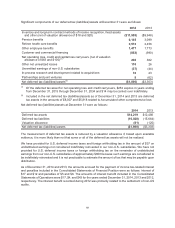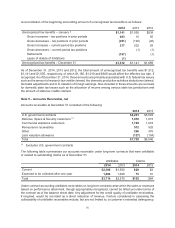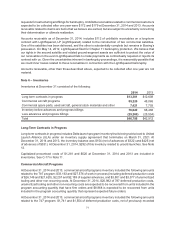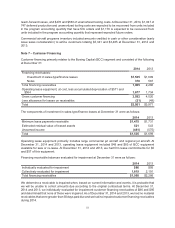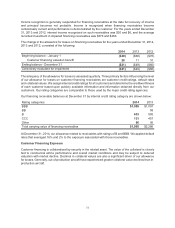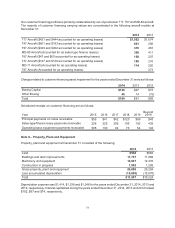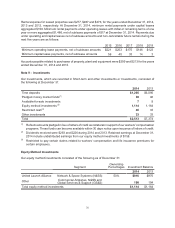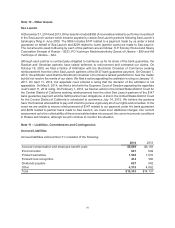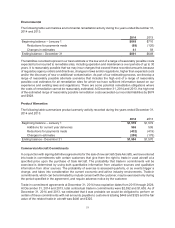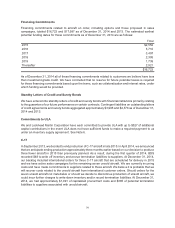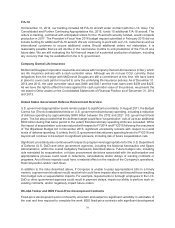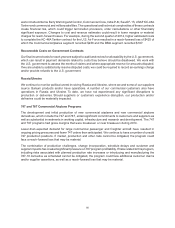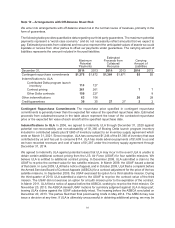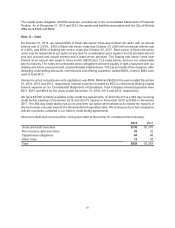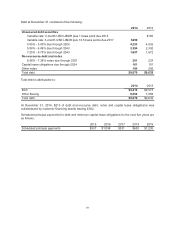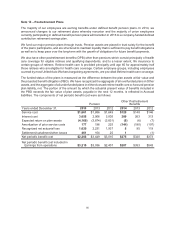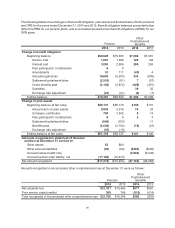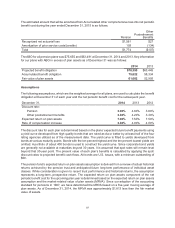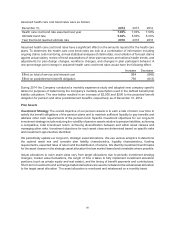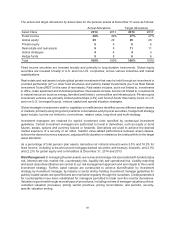Boeing 2014 Annual Report Download - page 91
Download and view the complete annual report
Please find page 91 of the 2014 Boeing annual report below. You can navigate through the pages in the report by either clicking on the pages listed below, or by using the keyword search tool below to find specific information within the annual report.79
F/A-18
At December 31, 2014, our backlog included 68 F/A-18 aircraft under contract with the U.S. Navy. The
Consolidated and Further Continuing Appropriations Act, 2015, funds 15 additional F/A-18 aircraft. The
orders in backlog, combined with anticipated orders for the 15 aircraft currently funded, would complete
production in 2017. The President’s Fiscal Year 2016 budget request submitted in February 2015 did not
include funding for additional F/A-18 aircraft. We are continuing to work with our U.S. customer as well as
international customers to secure additional orders. Should additional orders not materialize, it is
reasonably possible that we will decide in the next twelve months to end production of the F/A-18 at a
future date. We are still evaluating the full financial impact of a potential production shutdown, including
any recovery that may be available from the U.S. government.
Company Owned Life Insurance
McDonnell Douglas Corporation insured its executives with Company Owned Life Insurance (COLI), which
are life insurance policies with a cash surrender value. Although we do not use COLI currently, these
obligations from the merger with McDonnell Douglas are still a commitment at this time. We have loans
in place to cover costs paid or incurred to carry the underlying life insurance policies. As of December 31,
2014 and 2013, the cash surrender value was $466 and $451 and the total loans were $439 and $425.
As we have the right to offset the loans against the cash surrender value of the policies, we present the
net asset in Other assets on the Consolidated Statements of Financial Position as of December 31, 2014
and 2013.
United States Government Defense Environment Overview
U.S. government appropriation levels remain subject to significant uncertainty. In August 2011, the Budget
Control Act (The Act) established limits on U.S. government discretionary spending, including a reduction
of defense spending by approximately $490 billion between the 2012 and 2021 U.S. government fiscal
years. The Act also provided that the defense budget would face “sequestration” cuts of up to an additional
$500 billion during that same period to the extent that discretionary spending limits are exceeded. While
the impact of sequestration cuts was reduced with respect to FY2014 and FY2015 following the enactment
of The Bipartisan Budget Act in December 2013, significant uncertainty remains with respect to overall
levels of defense spending. It is likely that U.S. government discretionary spending levels for FY2016 and
beyond will continue to be subject to significant pressure, including risk of future sequestration cuts.
Significant uncertainty also continues with respect to program-level appropriations for the U.S. Department
of Defense (U.S. DoD) and other government agencies, including the National Aeronautics and Space
Administration, within the overall budgetary framework described above. Future budget cuts, including
cuts mandated by sequestration, or future procurement decisions associated with the authorization and
appropriations process could result in reductions, cancellations and/or delays of existing contracts or
programs. Any of these impacts could have a material effect on the results of the Company’s operations,
financial position and/or cash flows.
In addition to the risks described above, if Congress is unable to pass appropriations bills in a timely
manner, a government shutdown could result which could have impacts above and beyond those resulting
from budget cuts or sequestration impacts. For example, requirements to furlough employees in the U.S.
DoD or other government agencies could result in payment delays, impair our ability to perform work on
existing contracts, and/or negatively impact future orders.
KC-46A Tanker and BDS Fixed-Price Development Contracts
Fixed-price development work is inherently uncertain and subject to significant variability in estimates of
the cost and time required to complete the work. BDS fixed-price contracts with significant development


